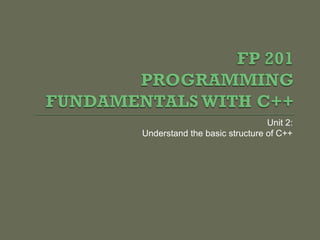
Fp201 unit2 1
- 1. Unit 2: Understand the basic structure of C++
- 2. Objectives Evolution of C++ Structure of C++ program • Preprocessor directives • Header files • Main() function • Return statement Hands On!
- 3. At the end of this presentation, you will be able to: • Describe the general structure of C++ programs • Write a simple C++ programme
- 4. Bjarne Stroustrup founded C++ in mid 80’s. C++ was developed at AT&T Bell laboratories. Additional features than C. Features are closer to the real world solution.
- 5. Include File (must have) Class declaration (if any) Class Member Function definition (if any) Main function (must have)
- 6. Header file Description <cassert> Contains macros and information for adding diagnostic that aid program debugging <cstring> Contains function prototype for C-style string processing <cmath> Contains function prototype for math library function <iostream> Contains function prototype for standard input and standard output function <iomanip> Contains function prototype for stream manipulator that enable formatting of streams of data <fstream> Contains function prototype for functions that perform input from files on disk and output to files on disk.
- 7. <preprocessor directive> <main function> { <variable declaration> …. <C++ statement> …. <return statement(if any)> }
- 8. //First C++ Program Comment #include <iostream> Preprocessor Directive using namespace std; int main() Main Function { int a; Variable Declaration cout << “Hello World!”; cin >> a; Statement return 0; }
- 9. Line 1: // First C++ program • comment line. • ignored by the compiler and do not have any effect on the executable. • comments in programs help the programmer (and users) to understand what the program (or section) does. • C++ supports two types of comments: // line comment /* block comment */
- 10. Line 2: #include <iostream> • lines beginning with a hash (or pound) sign (#) are directives for the preprocessor. • runs before the compiler each time the compiler is invoked. • translates any line that begins with a hash symbol (#) into a special command, getting your code file ready for the compiler. • #include <iostream> tells the preprocessor to include the iostream standard file which contains the declarations of the basic standard input-output library in C++.
- 11. Line 3: using namespace std; • namespace allows to group entities like variables, classes, objects and functions under a name. • elements belonging to the standard C++ library are declared in what is called a std namespace. • example: cout is defined under std namespace where you can see the details in the file <iostream>. • if you omit this line, in order to use cout, you need to write the name of the namespace (std) followed by scope operator (::) before cout. Eg: std::cout << "Hello world!";.
- 12. Line 4: empty line • An empty line does nothing except for help the programmer to view the source code more clearly. Line 5: int main() • actual program starts must start with a function named main(). • every C++ program has only one main() function.
- 13. Lines 6 and 11: The body of the main() function is enclosed in braces ({ }). Line 8: cout << "Hello World!"; this line is a C++ statement which performs the only action that generates a visible effect in our first program. Each statement must end with a semicolon character (;). Here's how cout is used: type the word cout, followed by the output insertion (or redirection) operator (<<). Whatever follows the output insertion operator is output to the screen. If you want to output a string of characters be sure to enclose them in double quotes (" "), as shown on line 7, "Hello World!".
- 14. Line 10: return 0; • return statement causes the main() function (i.e. the program) to finish.
- 15. Write a program that outputs following lines to the screen: Welcome to the world of C++
- 16. #include <iostream> using namespace std; void main( ) { cout << “Welcome to the world of C++” }
- 17. Why does the following program fail? #include <iostreams> using namespace std; void main() { cout << “Is there a bug here?”; }
- 18. Because of the typo error for the preprocessor directive Wrong : iostreams Correct: iostream
- 19. Explain why we use std:: in the following program. What is the output of program? #include <iostream> void main() { std::cout << " ## # # "<< std::endl; std::cout << "# ### ###"<<std::endl; std::cout << " ## # # "<< std::endl; }
- 20. Refer to slide 11